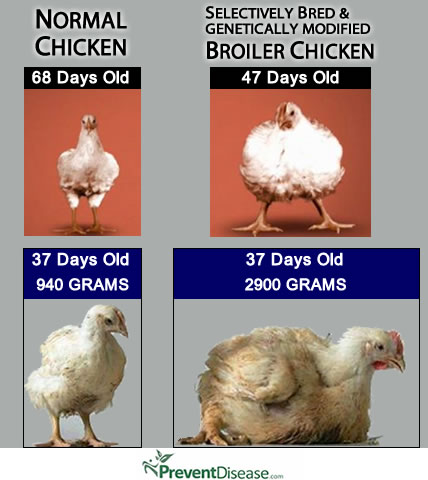
© Prevent Disease
Billions of chickens around the world suffer in the intensive farming systems every year. Broilers chickens have been selectively bred and genetically modified so that they are reared quickly and cheaply to have enough meat to fulfill demand. Most these chickens suffer from painful lameness and disease related to their growth rates.
Intensification of the broiler chicken industry started in the late 1950's, when the use of 'dual purpose' chickens for egg and meat production ceased and new poultry strains were produced specifically for meat production.
For example, in 1950, well under 50 million commercial broiler chickens were raised commercially, and now that number is well into the billions. When Kentucky Fried Chicken stores opened in the 1970s, production of these chickens skyrocketed over 40%.
The result of the narrowly focused breeding programs has been a bird which grows twice or three times as fast as a normal chicken and converts its food into meat in a much more efficient way. Most are raised under intensive systems and reach slaughter weight at 5-7 weeks of age. As a consequence the price of chicken meat has declined and consumption has risen several fold.
Intensive Selective Breeding Over 50 years ago it took 98 days for a chicken to grow to 1.6kg. By 1986, due to selective breeding, it only took 37 days. Baby birds, who still chirp and have soft feathers, have the bodies of adult birds. This unnatural growth rate puts enormous pressure on the heart and immature skeleton and is the cause of many health problems.
Extreme selection pressure for large breast muscles has further distorted the anatomy of these animals and puts great pressure on their developing legs. They often therefore crouch down with their large breast on the floor of the shed. This frequent contact with the floor of the shed may lead to painful ulceration of the skin known as breast blister.
Lameness caused by dislocation of joints and bone fractures are major and unavoidable consequence of selective breeding for increased growth rates. Many birds are unable to walk or even stand up well, resulting in "hockburn" as they waddle around in the damp ammonia-soaked litter. Skin problems are exacerbated by the progressive build up of moisture and droppings in the litter. Around 2% of birds die in the sheds from illness, trauma and starvation when they are unable to reach food and water, or are trampled by other birds.
Selective breeding for rapid growth rates has also led to a syndrome associated with inability of the heart to adapt to the rapid increase in the body. Called Acute Death Syndrome (ADS) or Sudden Death Syndrome (SDS), the cause of death is heart failure and pulmonary oedema, with the animals essentially drowning due to fluid accumulation in the lungs.
Few animals which have been selectively bred would survive in the wild. This is certainly true of the meat chicken. Broiler chickens which are spared from slaughter often die young.
This is a problem for those who wish to breed broiler chickens. To keep the parent birds healthy, they have to be restricted to a quarter of their normal diet while they are growing. They have been bred to be hungry so they grow fast, but to keep them healthy they have to be kept hungry.
Artificial Selection is another name for selective breeding. In the wild, natural selection weeds out animals which are not adapted to their environment. Artificial selection may be useful to us, but it may produce animals which are more likely to suffer.
Broiler chickens live in extremely crowded, barren environments. By slaughter, each bird has only a half-square foot (465 sq cm) of space. That's less than the size of a computer mouse pad. These barren and confining conditions deny animals opportunity to express natural behaviours, and lead to physical and behavioural problems. There is social chaos as thousands of chickens mill about, with too many birds for a well-defined pecking order to develop. Normal behaviour patterns are impossible. Individuals become stressed and aggressive to neighbours.
Dr Toby Knowles of Bristol University's Division of Food Animal Science and colleagues assessed the walking ability of 51,000 chickens within 176 flocks. They also obtained information on approximately 150 different management factors associated with each flock.
The study found that at an average age of 40 days, over 27.6 per cent of birds showed poor locomotion and 3.3 per cent were almost unable to walk. The high prevalence of poor locomotion occurred despite culling policies designed to remove severely lame birds from flocks.
Dr Knowles said: "Broiler chickens have been subjected to intense genetic selection. In the past 50 years, broiler growth rates have increased by over 300 per cent from 25 g per day to 100 g per day.
"Our research shows that the primary risk factors associated with impaired locomotion and poor leg health are those specifically associated with rate of growth."
Other factors include the age of the bird, bird genotype, not feeding whole wheat, a shorter dark period during the day, higher stocking density, no use of antibiotic and the use of intact feed pellets.
There is near-continuous lighting in the barns: 23 hours on, one hour off, in order to stimulate higher food consumption.
Scientists have even
promoted featherless cross bred chickens of this kind for mass poultry farming.
A
39 day blog on chickenout.tv follows the very disturbing life of a factory farmed broiler chickens.
Sources:Sources:
Humanefood Canada
Chickenout TV
CIWF Org UK
Science Daily
Reader Comments
to our Newsletter